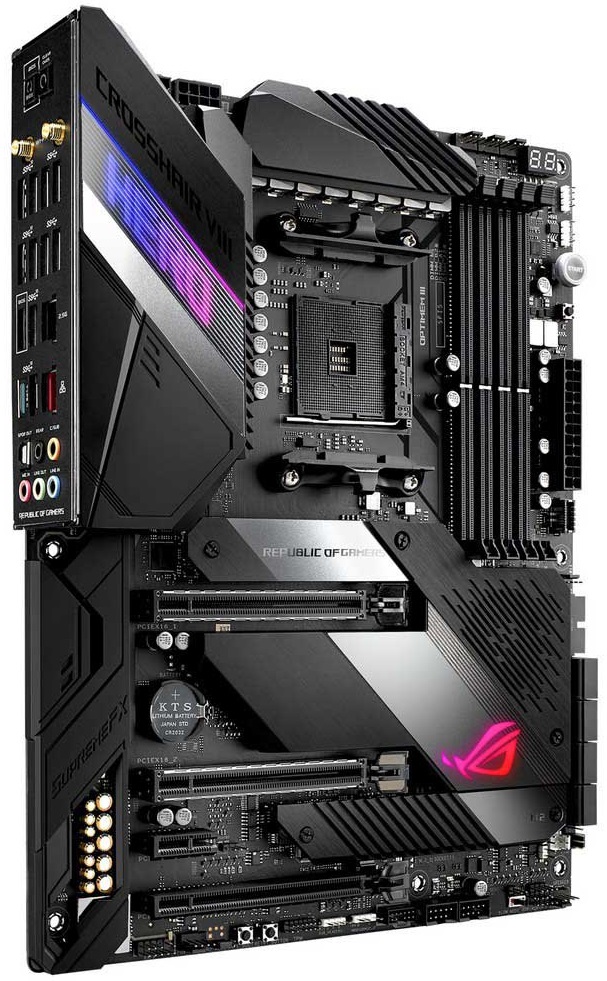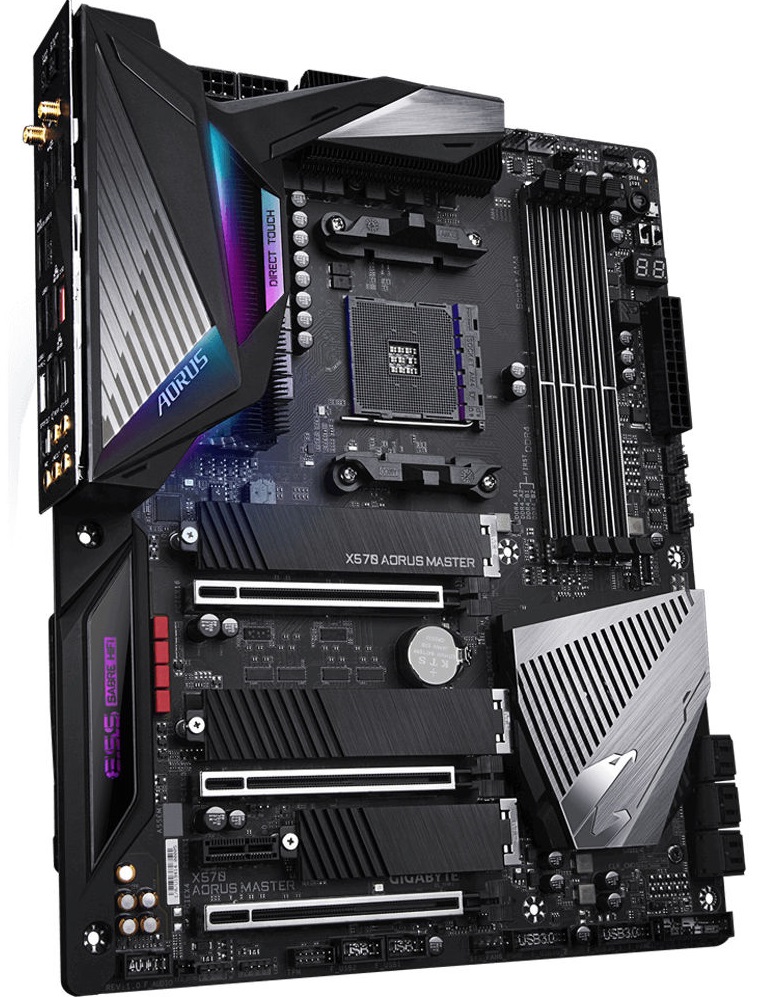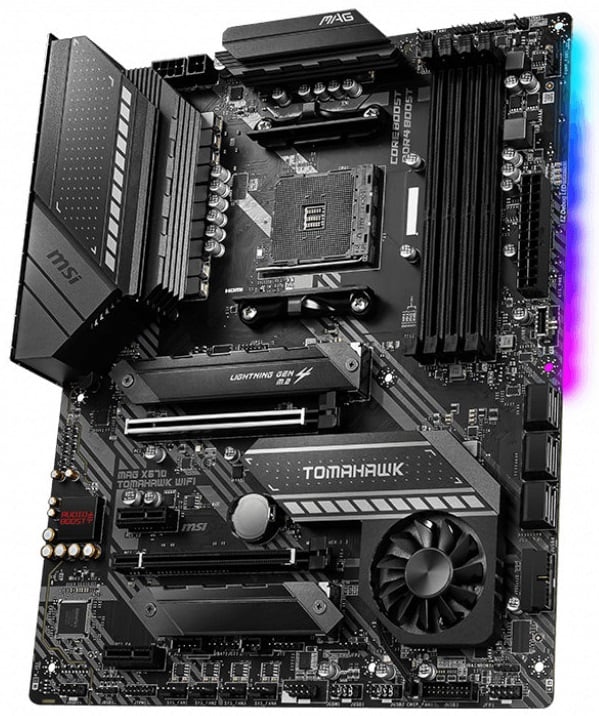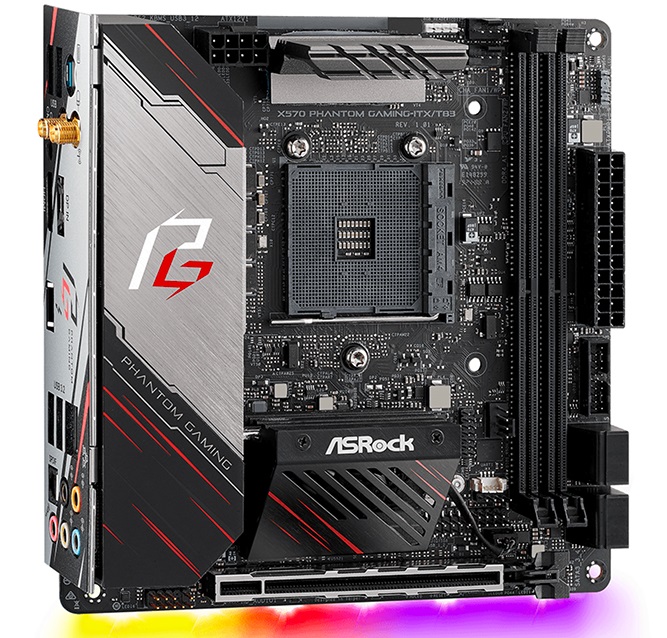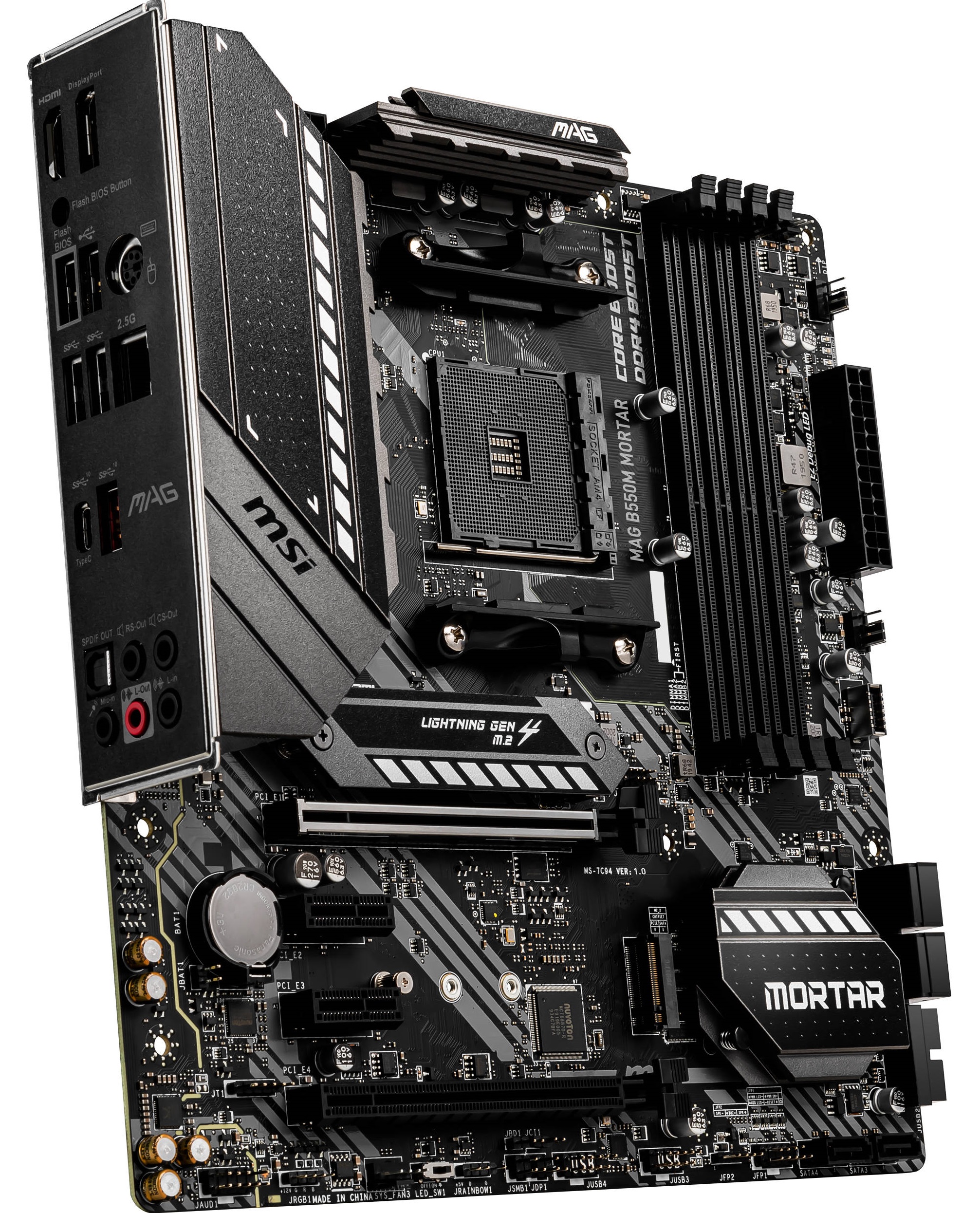One of the best things about the Ryzen 5000 series is that it is drop-in compatible with the existing X570 and B550 chipsets with, at most, a BIOS update required. Due to this reason, there are dozens of Ryzen 5000 compatible motherboards out there. Not only that, support for the older B450 motherboards and X470 motherboards is also confirmed, both by AMD and by consumers. This is a great step since that gives users on older CPUs like 1st Gen Ryzen a direct path of an upgrade to the Ryzen 5000 series. With that out of the way, let’s get into our picks for the best motherboards that support Ryzen 5000 out of the box.
Best Motherboards For Ryzen 5000 Series CPUs
It is not all that simple to crown one motherboard as the best motherboard for Ryzen 5000 series CPUs. Since these CPUs are among the best CPUs for gaming and productivity, they do have somewhat advanced requirements. The CPUs are each targeted at different price brackets, it would be silly to mention just one motherboard as the all-around best motherboard you can buy for this series. Keeping that in mind, here are our picks for the top 5 motherboards you should consider when buying your next Ryzen 5000 series gaming CPUs. The ASUS Crosshair series is the flagship motherboard line from ASUS with extremely sturdy boards targeted at extreme overclockers. The Crosshair Hero is one of the more reasonable boards that is still overkill for a lot of mainstream users but not as much as some of the other options in the Crosshair series. The Hero features 4 DIMM slots which can support up to 128GB of RAM with speeds up to 4800 MHz. This means that the Crosshair Hero has support for the latest and greatest that the memory world can offer. Its efficient VRM means that it can handle high-speed memory overclocking as well.
Speaking of the VRM, the Hero packs one of the finest power delivery systems of any X570 motherboard out there, making it ideal for extreme overclocking. The motherboard’s powerful and critically-acclaimed 8-phase VRM design enables it to handle even the new 16-core Ryzen 9 5950X at overclocked settings. This is by far one of the best motherboards compatible with Ryzen 9 5950X. 8 phases might seem low in comparison with other boards but ASUS configures their phase count differently so they are not directly comparable. In addition to that, ASUS has included onboard thermal sensors, onboard power and reset buttons, and a BIOS Flashback feature with a button on the rear I/O. These are all nice-to-have features that help the Crosshair justify its hefty price tag. Moreover, the Hero can support a pair of GPUs since it has multiple PCIe Gen 4 x16 slots. This enables the Crosshair to support technologies such as NVLink or SLI for multiple GPUs operating in tandem. In the world of storage, the Crosshair is equipped with 2 NVMe drives, both of which support full PCIe Gen 4 operation. This enables the Crosshair to make use of the bleeding edge in the world of storage. A big plus in the Hero’s favor is its incredible connectivity. With a whopping 10 USB Type-A ports as well as a USB Type C connector for the front I/O, the Crosshair has incredible connectivity support for those who have a lot of USB devices. Moreover, the Crosshair also supports Gigabit Ethernet as well as WiFi. Other Reads: Best Motherboards for i7 8700K Aesthetically, the Hero is a beautiful board. Not only does it have a color-neutral, stealthy look with big beefy heatsinks, but it also supports a dash of RGB which helps to personalize the look of the board if the user sees fit. The board features two zones of RGB which can be customized via the Aura Sync software. The board also features a built-in IO shield as well as full coverage M.2 heatsinks which, although they do look beautiful, make removing the drives a bit of a chore. Conclusively though, the Hero is an incredible high-end offering from ASUS. The only disadvantage of this board is its hefty price tag which might not be in the range of most users. Still, we hold this board as the best overall motherboard for Ryzen 5000 series CPUs on our list. Another premium AMD board makes the list, this time from Gigabyte. The Aorus Master is the second highest board in Gigabyte’s lineup, just behind the $700 Aorus Extreme. While the Extreme is also Extremely expensive, the Master delivers most of Extreme’s features at a more consumer-friendly price. Delivering a superb 14-phase VRM design with premium components, the X570 Aorus Master is one of the most reliable CPU overclocking options out there. This definitely earns it the title of the best overclocking motherboard for Ryzen 5000 series CPUs.
Cooled by a beefy metal heatsink array, the Aorus Master’s power delivery system is among the best in the X570 series. This board can even keep an overclocked 16-core Ryzen 9 5950X perfectly stable. The Aorus Master has great memory support as well, supporting 4 DIMMs up to 128GB, and clocked as high as 4400 MHz. The Aorus Master also features 3 PCIe Gen 4 slots which can support 2 GPUs in an SLI configuration easily. Even more impressive is the fact that the Aorus Master has 3 PCIe Gen 4 M.2 NVMe slots, which is even more than the Crosshair Hero. This makes the Aorus Master a great choice for people with multiple M.2 drives or even users who want to experience RAID with their drives. The only drawback to this approach is that when all 3 M.2 slots are populated, only 4 SATA ports on the Aorus Master remain functional which can be a bit concerning for users with more SATA devices. As far as looks go, the Aorus Master is a fine specimen. The board looks solid and features large heatsinks not only over the VRMs but also on the chipset which contains a small fan as well to help in active cooling. The 3 M.2 slots also feature black stealthy heatsinks, while the PCIe slots are reinforced with metal which also improves the aesthetics of the board. Finally, the board also features a decent helping of RGB over the IO cover as well as the lower left of the board. This helps the user to personalize the look of the board via Gigabyte’s RGB Fusion software. Other AMD Motherboards Guide: Best A320 Motherboards All in all, the Aorus Master is one of the finest X570 motherboards out there and it would be a perfect fit for an overclocked Ryzen 5000 series CPU. The beefy 14-phase power delivery is an attractive feature for potential overclockers, and there is nothing specifically bad about the board that immediately jumps out. Overall, a definite recommendation if you can afford it. MSI’s whole early X570 line was a royal disaster with boards like the X570A-Pro delivering worse performance than MSI’s budget B450 line. Fans were extremely let down after MSI’s poor power delivery design in the MSI X570A-Pro, MSI X570 Gaming Plus, and MSI X570 Gaming Pro Carbon, and the insult was compounded due to the fact that MSI’s B450 Tomahawk lineup had risen to an almost legendary acclaim status in the community. The X570 series was such a disappointment that MSI labeled their X570 Tomahawk a “Return to Honor” on their website. If budget motherboards are your preference, you should also check out our picks for the best AM4 motherboards under $100.
It would be an understatement to say that the MAG X570 Tomahawk lived up to those words. Featuring a power delivery design that rivaled the Aorus Master and MSI’s own X570 UNIFY in quality, the X570 Tomahawk punched way above its weight. It might not be the most flashy board out there, but what it has is a VRM that manages to handle even the most core-heavy overclocked CPUs out there. The Tomahawk also supports DDR4 memory in 4 DIMM slots, up to 128GB, and running as fast as 4600 MHz. This includes some of the fastest Ryzen 5000 series memory speed options out there. MSI has included an 8pin + 4pin ATX 12V CPU power connector design on their board which allows the board to draw more power if need be to keep overclocked CPUs stable under intense loads. Coupled with some extensive heatsinks, the Tomahawk is a truly great motherboard when it comes to overclocking. 2 M.2 Slots are also included which allow the Tomahawk to run 2 PCIe Gen 4 SSDs under the included metal heatsinks. MSI’s X570 Tomahawk delivers the essentials in connectivity as well, with plenty of USB ports, SATA ports, 2.5GbE Ethernet, and WiFi built-in as well. Aesthetically the board can appear a bit plain but it does look like it was built with a tank in mind, and it fits that description nicely. The RGB strip is on the backside of the motherboard’s right edge which is a questionable decision. The MSI MAG X570 Tomahawk is labeled as MSI’s “Return to Honor” and it certainly fulfills that promise. Affordable, yet extremely reliable, the Tomahawk X570 is our default choice for X570 boards at $200-250. This earns it the title of the best value motherboard for Ryzen 5000 series CPUs as well. ASRock has made some fine X570 and B450/B550 boards in the past and this one is no exception. The specialty of the X570 Phantom Gaming ITX is that, well, it is a Mini-ITX small form factor board. This opens up a world of opportunities for small form factor enthusiasts who can now cram a whole lot of power in a tiny enclosure with the Ryzen 5000 series and the ASRock Phantom Gaming X570 ITX. The ASRock offering is definitely the best mini-ITX motherboard for Ryzen 5000 series CPUs in our opinion.
The X570 Phantom Gaming ITX packs one of the finest power delivery systems of any X570 board into a tiny form factor. This enables the possibility of potential 16-core Ryzen 9 5950X systems inside tiny enclosures, which is an attractive thought to any small form factor enthusiast. In addition to the nice VRMs, the X570 Phantom Gaming also packs Gigabit LAN and WiFi which are nice connectivity features in a small board. On a related note, check out our picks for the best mini-ITX cases for your compact build as well. Due to its small size, the Phantom Gaming ITX only features 2 DIMM slots with support for a maximum capacity of 64GB running at up to 4533 Mhz speeds. Therefore, the board will support most of the Ryzen 5000 series compatible RAM out there. This limits the upgrade options for people with 8 or 16GB memory modules but that is standard on Mini-ITX. There is only 1 PCIe Gen 4 M.2 slot, only 1 PCIe Gen 4 card slot, and only 4 SATA ports so people with a lot of drives need to take that into consideration as well. One of the most unique features of the Phantom Gaming ITX is the inclusion of Thunderbolt 3, which opens up a vast number of possibilities for people who can utilize the potential of that link. Aesthetically, the board is nice looking with aggressive red and black patterns and also an integrated RGB implementation at the lower end of the board. It also features a built-in IO shield. The combination of high-end power delivery with the inclusion of all the necessary features in a small form factor makes the ASRock X570 Phantom Gaming ITX/TB3 our recommendation for Mini-ITX enthusiasts. Our final pick of the day comes from the budget-oriented B550 line rather than the premium X570 lineup of motherboards. The MAG B550M Mortar furthers the legacy of the B450 Tomahawk and B450 Mortar by improving the power delivery system and adding a lot of key features. The B550M Mortar is also a Micro-ATX board which would be a welcome feature for those of you rocking compact cases. There are several Ryzen 5000 motherboard chipset options out there, but B550 is one of the more budget-oriented ones. Since this is a B550 board, you can be sure that you can get either a B550 or X570 motherboard for Ryzen 5000 series.
More AMD Motherboards: Best X399/TR4 Motherboards Arguably the best thing about the B550M Mortar is its price. At $160, it does not get a whole lot better than this. Well, there is the B550 Tomahawk which is the ATX variant of this board and packs the same power delivery system with some extra PCIe slots but most of that functionality can still be had with the Mortar. The B550M Mortar packs a decent 8+2+1 phase power design that will pair nicely with a Ryzen 5 5600X for a strong mid-range build. It has 4 DIMM slots that support RAM up to 128GB running at up to 4400 MHz. Expansion-wise, we’re looking at 1 PCIe Gen 4 x16 Slot and 1 PCIe Gen 3 x4 Slot. In terms of storage, the Mortar has 6 SATA 6Gb/s ports as well as 2 M.2 slots which is really good for a B550 mATX board. Only the top M.2 slot is wired up for PCIe Gen 4 though, so this should be kept in mind when making a purchase decision. Connectivity is covered well with 2 x USB 3.2 Gen 1, 1 x USB 3.2 Gen 2, 1 x USB 3.2 Gen 2 Type-C, 2x USB 2.0 ports as well as 2.5GbE Ethernet. Furthermore, we would have liked to see the inclusion of Wi-Fi as well since that is a very commonly-used feature, however, that problem can be rectified using an inexpensive PCIe WiFi card. The MSI MAG B550M Mortar is a great option for those looking for flagship features in a budget, mATX option. If you’re looking for ATX, the MSI MAG B550 Tomahawk is the same board but in a bigger form factor. At $160, The B550M Mortar seals the deal as our pick for the best budget motherboard for Ryzen 5000 series CPUs. It is also one of the cheapest Ryzen 5000 motherboard options on the market.
Things To Know Before Buying Ryzen 5000 Series Motherboard
It is common knowledge that the motherboard lays the foundation of a computer system. It is one of the most crucial PC components that many builders cut corners on and blindly trust the “gaming features” listed on the manufacturer’s box. Manufacturers don’t really provide the details necessary to clear up our minds before we make our final decision apart from the chipset, RGB, Wi-Fi, and ability to overclock. Making the wrong choice, such as pairing a high-end Ryzen 9 5950X processor with an A520 motherboard, can have catastrophic effects down the line. One should keep in mind some factors while shopping for the best motherboard for Ryzen 5000 series. The VRM is the primary thing we should look for. The voltage regulating modules are responsible for power delivery to your CPU. It steps down the voltage coming from the PSU to operate the CPU in safe conditions. It is extremely important to focus on VRMs when shopping for a motherboard. The quality and design of the VRM can greatly affect CPU performance. Good quality VRMs are long-lasting, stably maintain higher power delivery and overclocks. Poor quality VRMs on the other hand are unstable, cannot maintain high power delivery, and can be a risk for the life of the CPU. Moreover, the high-end motherboards are equipped with heatsinks to pull heat away from the VRMs, further ensuring longevity and stability. Apart from the VRM, we should also take a look at the upgrade path that the motherboard platform provides us. Many people want to future-proof their builds, reducing the need to change the components whenever upgrading to something better and newer. Fortunately upgrading on an AMD motherboard is easy since one chipset is compatible with many generations of AMD Processors, and Ryzen 5000 motherboard compatibility is also really wide. Conclusively, these are some of the more important factors that one should consider while shopping for a new motherboard in 2022, especially for the Ryzen 5000 series.
AMD Ryzen 5000 Series Desktop CPUs With ZEN 3 Cores Official Promising Fastest…Intel 11th-Gen Core Series ‘Rocket Lake’ CPUs For Desktops Arriving Early Next…5 Best RAM Kits for AMD Ryzen 5000 Series in 2022AMD ZEN 3 Ryzen 5000 Series Desktop-Grade CPUs Will Benefit From DDR4-4000 RAM…












